Renault CLIO 2007 Owner Manual

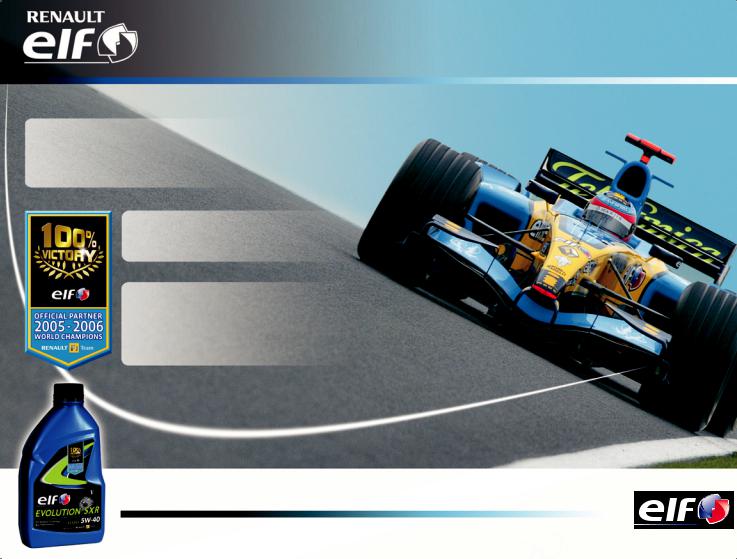
ELF is developing a complete range of lubricants for RENAULT: engine oils, manual and automatic transmission oils.
These are very high-technology lubricants stimulated by applied research in Formula One.
This range is updated with RENAULT’s engineering teams to perfectly meet the specific needs of RENAULT vehicles.
ŹELF lubricants are a major factor in your vehicle’s performance.



 recommends ELF
recommends ELF
Important: to optimize engine operation the use of a lubricant may be restricted to certain vehicles. See your owner’s manual.
RENAULT recommends the approved ELF lubricants for your oil changes and top-ups. Contact your RENAULT representative or visit the site: www.lubricants.elf.com
The oil born in Formula One

Quick overview
 – Tyre pressures . . . . . . . . . . . . . . . . . . . . . . . . . . . . . . . . . . . . . . . . . . . . . . 0.4 – 0.5
– Tyre pressures . . . . . . . . . . . . . . . . . . . . . . . . . . . . . . . . . . . . . . . . . . . . . . 0.4 – 0.5
 – Adjusting the seats and driver’s position . . . . . . . . . . . . . . . . . . . . . . . . 1.9 → 1.13
– Adjusting the seats and driver’s position . . . . . . . . . . . . . . . . . . . . . . . . 1.9 → 1.13
 – Child restraints/seats . . . . . . . . . . . . . . . . . . . . . . . . . . . . . . . . . . . . . . 1.25 → 1.33
– Child restraints/seats . . . . . . . . . . . . . . . . . . . . . . . . . . . . . . . . . . . . . . 1.25 → 1.33
 – Warning lights. . . . . . . . . . . . . . . . . . . . . . . . . . . . . . . . . . . . . . . . . . . . 1.38 → 1.43
– Warning lights. . . . . . . . . . . . . . . . . . . . . . . . . . . . . . . . . . . . . . . . . . . . 1.38 → 1.43
 – Audible and visible signals . . . . . . . . . . . . . . . . . . . . . . . . . . . . . . . . . . 1.50 → 1.53
– Audible and visible signals . . . . . . . . . . . . . . . . . . . . . . . . . . . . . . . . . . 1.50 → 1.53
 – De-icing . . . . . . . . . . . . . . . . . . . . . . . . . . . . . . . . . . . . . . . . . . . . . . . . . . . . . . 1.56
– De-icing . . . . . . . . . . . . . . . . . . . . . . . . . . . . . . . . . . . . . . . . . . . . . . . . . . . . . . 1.56
 – Running in, driving . . . . . . . . . . . . . . . . . . . . . . . . . . . . . . . . . . . . . . . . . 2.2 → 2.28
– Running in, driving . . . . . . . . . . . . . . . . . . . . . . . . . . . . . . . . . . . . . . . . . 2.2 → 2.28
 – Heating and air conditioning system . . . . . . . . . . . . . . . . . . . . . . . . . . . 3.4 → 3.19
– Heating and air conditioning system . . . . . . . . . . . . . . . . . . . . . . . . . . . 3.4 → 3.19
 – Opening the bonnet . . . . . . . . . . . . . . . . . . . . . . . . . . . . . . . . . . . . . . . . . . . . . . 4.2
– Opening the bonnet . . . . . . . . . . . . . . . . . . . . . . . . . . . . . . . . . . . . . . . . . . . . . . 4.2
 – Levels (engine oil, windscreen washer etc.). . . . . . . . . . . . . . . . . . . . . . 4.3 → 4.11
– Levels (engine oil, windscreen washer etc.). . . . . . . . . . . . . . . . . . . . . . 4.3 → 4.11
 – Emergency spare wheel. . . . . . . . . . . . . . . . . . . . . . . . . . . . . . . . . . . . . . 5.2 → 5.5
– Emergency spare wheel. . . . . . . . . . . . . . . . . . . . . . . . . . . . . . . . . . . . . . 5.2 → 5.5
 – Practical advice (changing bulbs, fuses, breakdown, operating faults) . 5.2 → 5.35
– Practical advice (changing bulbs, fuses, breakdown, operating faults) . 5.2 → 5.35
0.2
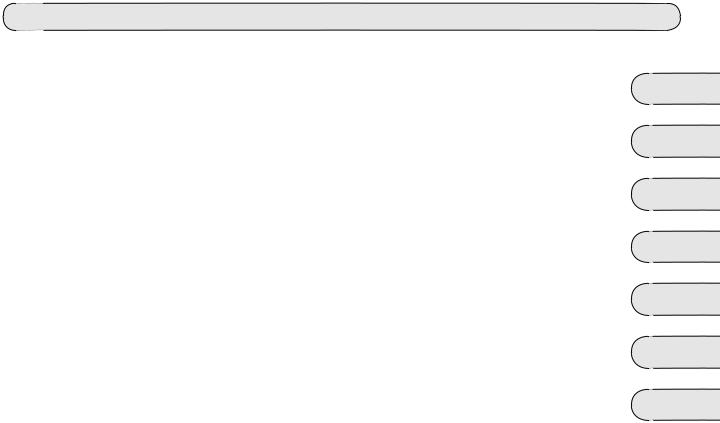
C O N T E N T S
Sections
Getting to know your vehicle ...............................
Driving ...................................................................
Your comfort .........................................................
Maintenance .........................................................
Practical advice ....................................................
Technical specifications ......................................
Alphabetical index ...............................................
1
2
3
4
5
6
7
0.3

TYRE PRESSURE WHEN COLD (in bar or kg/cm² when cold)
Versions |
1.2 |
|
1.4 16V |
1.6 16V |
|
1.2 16V |
|
1.5 dCi |
|||
|
|
|
|
||
|
|
|
|
|
|
Tyre dimensions |
175/65 R14 T |
|
175/65 R14 T |
185/55 R15 H |
|
|
|
185/55 R15 H |
|
185/55 R15 H |
|
|
|
|
|
|
|
Normal use (1) |
|
|
|
|
|
– |
Front |
1.9 |
|
2.2 |
2.3 |
– |
Rear |
1.8 |
|
2 |
2 |
|
|
|
|
|
|
Motorway use (1) |
|
|
|
|
|
– |
Front |
2.1 |
|
2.3 |
2.4 |
– |
Rear |
1.9 |
|
2.1 |
2.2 |
|
|
|
|
|
|
Wheel sizes |
|
5.5 J 14 |
6.0 J 15 |
||
|
6.0 J 15 |
||||
|
|
|
|
||
|
|
|
|
|
|
Tyre safety and use of chains
Refer to the information on “Tyres” in Section 5 for the servicing conditions and, depending on the version, the use of chains.
(1) Special note concerning vehicles used under full load (maximum permissible all-up weight) and towing a trailer:
Maximum speed must be limited to 60 mph (100 km/h) and the tyre pressure increased by 0.2 bar (or 3 PSI). Refer to the information on “Weights” in section 6 for more details.
0.4

TYRE PRESSURE WHEN COLD (in psi when cold)
Versions |
1.2 |
|
1.4 16V |
1.6 16V |
|
1.2 16V |
|
1.5 dCi |
|||
|
|
|
|
||
|
|
|
|
|
|
Tyre dimensions |
175/65 R14 T |
|
175/65 R14 T |
185/55 R15 H |
|
|
|
185/55 R15 H |
|
185/55 R15 H |
|
|
|
|
|
|
|
Normal use (1) |
|
|
|
|
|
– |
Front |
28 |
|
32 |
33 |
– |
Rear |
26 |
|
29 |
30 |
|
|
|
|
|
|
Motorway use (1) |
|
|
|
|
|
– |
Front |
30 |
|
33 |
34 |
– |
Rear |
28 |
|
30 |
32 |
|
|
|
|
|
|
Wheel sizes |
|
5.5 J 14 |
6.0 J 15 |
||
|
6.0 J 15 |
||||
|
|
|
|
||
|
|
|
|
|
|
Tyre safety and use of chains
Refer to the information on “Tyres” in Section 5 for the servicing conditions and, depending on the version, the use of chains.
(1) Special note concerning vehicles used under full load (maximum permissible all-up weight) and towing a trailer:
Maximum speed must be limited to 60 mph (100 km/h) and the tyre pressure increased by 0.2 bar (or 3 PSI). Refer to the information on “Weights” in section 6 for more details.
0.5
0.6

Section 1: Getting to know your vehicle
Keys - Remote control locking units . . . . . . . . . . . . . . . . . . . . . . . . . . . . . . . . . . . . . . . . . . . . . . . . . |
1.2 |
Doors. . . . . . . . . . . . . . . . . . . . . . . . . . . . . . . . . . . . . . . . . . . . . . . . . . . . . . . . . . . . . . . . . . . . . . . . . |
1.4 |
RAID (Renault Anti-Intruder Device) . . . . . . . . . . . . . . . . . . . . . . . . . . . . . . . . . . . . . . . . . . . . . . . . . |
1.6 |
Engine immobiliser . . . . . . . . . . . . . . . . . . . . . . . . . . . . . . . . . . . . . . . . . . . . . . . . . . . . . . . . . . . . . . |
1.7 |
Headrests – Seats. . . . . . . . . . . . . . . . . . . . . . . . . . . . . . . . . . . . . . . . . . . . . . . . . . . . . . . . . . . . . . . |
1.9 |
Seat belts/Additional restraint devices . . . . . . . . . . . . . . . . . . . . . . . . . . . . . . . . . . . . . . . . . . . . . . . |
1.14 |
Child safety . . . . . . . . . . . . . . . . . . . . . . . . . . . . . . . . . . . . . . . . . . . . . . . . . . . . . . . . . . . . . . . . . . . . |
1.25 |
Driving position . . . . . . . . . . . . . . . . . . . . . . . . . . . . . . . . . . . . . . . . . . . . . . . . . . . . . . . . . . . . . . . . . |
1.34 |
Instrument panel . . . . . . . . . . . . . . . . . . . . . . . . . . . . . . . . . . . . . . . . . . . . . . . . . . . . . . . . . . . . . . . . |
1.38 |
Trip computer and warning system . . . . . . . . . . . . . . . . . . . . . . . . . . . . . . . . . . . . . . . . . . . . . . . . . . |
1.44 |
Time and external temperature . . . . . . . . . . . . . . . . . . . . . . . . . . . . . . . . . . . . . . . . . . . . . . . . . . . . . |
1.47 |
Rear view mirrors . . . . . . . . . . . . . . . . . . . . . . . . . . . . . . . . . . . . . . . . . . . . . . . . . . . . . . . . . . . . . . . |
1.48 |
Steering wheel. . . . . . . . . . . . . . . . . . . . . . . . . . . . . . . . . . . . . . . . . . . . . . . . . . . . . . . . . . . . . . . . . . |
1.49 |
Exterior lighting and signals . . . . . . . . . . . . . . . . . . . . . . . . . . . . . . . . . . . . . . . . . . . . . . . . . . . . . . . |
1.50 |
Headlight beam adjustment. . . . . . . . . . . . . . . . . . . . . . . . . . . . . . . . . . . . . . . . . . . . . . . . . . . . . . . . |
1.52 |
Audible and visual signals. . . . . . . . . . . . . . . . . . . . . . . . . . . . . . . . . . . . . . . . . . . . . . . . . . . . . . . . . |
1.53 |
Wipers . . . . . . . . . . . . . . . . . . . . . . . . . . . . . . . . . . . . . . . . . . . . . . . . . . . . . . . . . . . . . . . . . . . . . . . . |
1.54 |
De-icing . . . . . . . . . . . . . . . . . . . . . . . . . . . . . . . . . . . . . . . . . . . . . . . . . . . . . . . . . . . . . . . . . . . . . . . |
1.56 |
Fuel tank (filling with fuel) . . . . . . . . . . . . . . . . . . . . . . . . . . . . . . . . . . . . . . . . . . . . . . . . . . . . . . . . . |
1.57 |
1.1

KEYS / RADIO FREQUENCY REMOTE CONTROLS
1 |
A
2 |
Doorsarelockedandunlockedusing remote control unit A.
It is supplied with power by a battery which must be replaced when the battery warning light 2 no longer lights up. (Refer to the information on “Remote control locking: batteries”).
Radio frequency remote control unit A
It can be identified by the presence of button 1.
1 Remote control door locking unit, coded ignition key, key for doors and fuel filler cap.
Driver’s responsibility
 Never leave the vehicle unattended with the key in the ignition if there is a child (or animal) in the vehicle. With the
Never leave the vehicle unattended with the key in the ignition if there is a child (or animal) in the vehicle. With the
key in the ignition, he or she could start the engine or operate electrical equipment such as the electric windows and there is a risk that part of their body may become trapped (neck, arm, hand, etc.). Risk of serious injury.
Door locking/unlocking
Press remote control for approximately one second (indicator light 2 comes on) to lock or unlock the doors.
–The hazard warning lights flash twice to indicate that the doors have been locked.
Note: If a door or the tailgate is not properly shut or is still open, or if a rear light is in the continuously lit position (refer to the relevant information in Section 3), the hazard warning lights do not flash.
–The hazard warning lights flash once to indicate that the doors have been unlocked.
1.2

KEYS/RADIO FREQUENCY REMOTE CONTROLS: general information
Radio frequency remote control range
This varies according to the environment. It is therefore important when handling the remote control to ensure that you do not lock or unlock the vehicle by inadvertently pressing the buttons.
Note: on certain vehicles, if a door is not opened within approximately 30 seconds of the door being unlocked by remote control, the doors will lock again automatically.
Interference
The presence of certain objects (metal objects, mobile telephones, or an area with strong electromagnetic radiation, etc.) close to the key may create interference and affect the operation of the system.
If you lose your keys or need another set of keys (or a remote control unit), contact your RENAULT Dealer.
–If you need to replace a key it will be necessary to take the vehicle and all its keys to your RENAULT Dealer in order to initialise the whole system.
–No more than four remote control units may be used for one vehicle.
If the remote control will not operate:
Make sure that the correct battery type is being used, and that the battery is in good condition and inserted correctly. These batteries should have a service life of approximately two years.
In this case, refer to the information on the “Radio frequency remote control: batteries”, in Section 5.
1.3
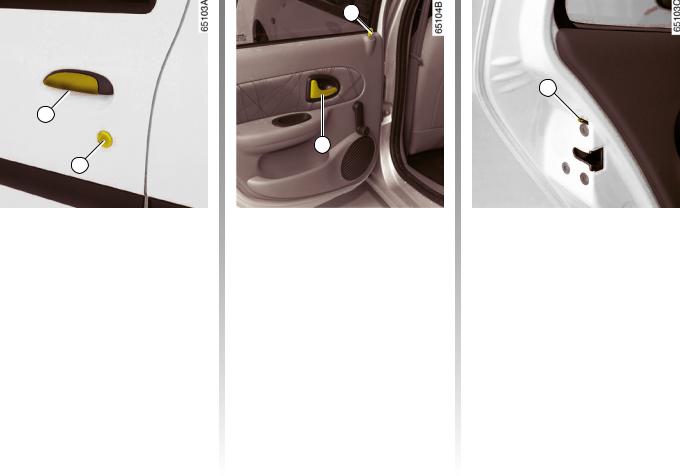
OPENING THE DOORS
1 |
2 |
Opening manually from the outside
Front: use the key to unlock front door lock 2. Place your hand behind handle 1 and pull it towards you.
Rear: if fitted to the vehicle, when the front door is open, lift unlocking knob 3 from inside and pull the door handle.
3 |
4 |
Opening manually from the inside
Pull handle 4.
Lights-on warning buzzer
If you have left the lights on after switching off the ignition, a reminder buzzer will sound when a door is opened (to prevent discharge of the battery, etc.).
5 |
Childproof locks
To make it impossible for the rear doors to be opened from the inside, move lever 5 on each door and check from the inside that the doors are securely locked.
1.4

LOCKING THE DOORS
1 |
Manual locking
Front: use the key from the outside.
Rear: if fitted to the vehicle, press down knob 1 on each door.
2 |
S Electric central locking
This enables the doors and the luggage compartment to be locked or unlocked simultaneously.
To lock, press the switch on the side with the padlock symbol 2.
The front door mechanism cannot be locked if the door is open.
Doors and tailgate status indicator light
The indicator light on switch 2 informs you of the closure status of the doors and tailgate:
–the indicator light is on when the doors/tailgate are locked;
–the indicator light goes out when a door or the tailgate is open (or incorrectly closed).
When you lock the doors using the remote control, the indicator light remains lit for approximately one minute then goes out.
If you decide to keep the doors locked when you are driving, remember that it may be more difficult for
those assisting you to gain access to the passenger compartment in the event of an emergency.
1.5

RENAULT ANTI-INTRUDER DEVICE (RAID)
You must first decide if you want to activate this function.
To activate
With the ignition on, press central door locking button 1 for about five seconds, until a beep is heard.
To deactivate |
1 |
With the ignition on, press central door locking button 1 for about five seconds, until a beep is heard.
If you decide to keep the doors locked when you are driving, remember that it may be more difficult for
those assisting you to gain access to the passenger compartment in the event of an emergency.
Operating principle
When the vehicle moves off, the system locks the doors automatically as soon as you reach a speed of approximately 4 mph (6 km/h). The indicator light on button 1 will light up.
The door is unlocked
–by opening a front door.
Note: if a rear door is opened, it will automatically be locked again when the vehicle reaches a speed of approximately 4 mph (6 km/h);
–by pressing door unlocking button 1.
Operating faults
If you find an operating fault (no automatic locking, the indicator light for button 1 does not light up when trying to lock the doors and tailgate, etc.), firstly check that the doors and tailgate are properly closed. If they are properly closed, contact your RENAULT Dealer.
Also make sure that locking has not been deactivated inadvertently. If this occurs, switch the ignition off and on again and reactivate it as described above.
1.6

ENGINE IMMOBILISER
This prevents the vehicle being driven by anyone not in possession of the vehicle’s coded ignition key.
1 |
Any repair or modification to the engine immobiliser (computer, wiring, etc.) may be dangerous. It must be
carried out by a qualified RENAULT technician.
Operating principle
The vehicle is automatically protected for a few seconds after the key is removed from the ignition.
When the ignition is switched on, indicator light 1 comes on for a few seconds and then goes off.
The vehicle has recognised the code and the engine can be started.
If the vehicle does not recognise the ignition key code, tell-tale light 1 will flash continuously and the engine cannot be started.
Indicator light
System operating tell-tale light
When the ignition is switched on, telltale 1 lights up continuously for approximately three seconds and then goes out. You can then start the engine.
Vehicle protection tell-tale light
A few seconds after the ignition has been switched off, tell-tale light 1 will flash constantly.
The vehicle will not be protected until the key has been taken out of the ignition.
1.7

ENGINE IMMOBILISER (continued)
1 |
Operating fault warning light
After the ignition has been switched on, if warning light 1 continues to flash or remains continuously lit, this indicates a system operating fault.
In all cases, it is essential to consult a RENAULT Dealer as only he is qualified to repair the engine immobiliser.
If the coded ignition key is faulty, use the second key (supplied with the vehicle).
1.8

FRONT HEADRESTS
A
1 |
2 |
|
Headrest with tab 1
To raise the headrest
Slide it upwards to the required height.
To lower the headrest
Move tab 1 forwards and lower the headrest down to the required height.
To adjust the angle of the headrest
Depending on the vehicle, tilt section A towards or away from you to the required position.
To remove the headrest
Press button 2 and lift the headrest to release it.
To refit the headrest
Insert the headrest rods into the holes, with the notches facing forwards.
Move tab 1 forwards and lower the headrest down to the required height.
The headrest is important for safety. Ensure that it is in place and in the correct position. The distance be-
tween your head and the headrest should be as small as possible. The top of your head should be in line with the top of the headrest.
1.9
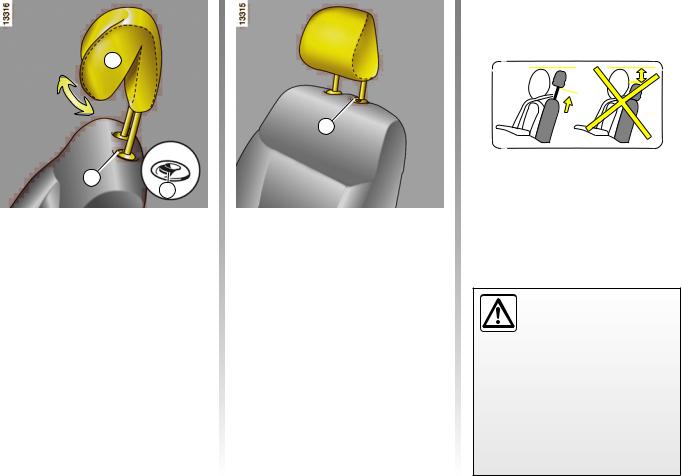
FRONT HEADRESTS (continued)
A
3 |
3 |
|
Headrest with tab 3
To raise or lower the headrest
Pull the headrest towards you (i.e. towards the front of the vehicle) and slide it up or down at the same time.
To adjust the angle of the headrest
On some vehicles the angle of the headrest can be adjusted. To do this, move the front section A of the headrest forwards or backwards until it feels comfortable.
3 |
To remove the headrest
First incline the seatback towards the rear.
Raise the headrest until it is at the highest possible setting. Lift up tab 3 and then pull the headrest upwards until it is released.
To refit the headrest
Insert the rods into the holes with the notches facing forwards.
Lower the headrest until it locks in position.
The headrest is important for safety. Ensure that it is in place and in the correct position. The distance be-
tween your head and the headrest should be as small as possible. The top of your head should be in line with the top of the headrest.
1.10

REAR HEADRESTS
1 |
1 |
To adjust the height
Simply slide it up.
To remove the headrest
Press tab 1.
To refit the headrest
Insert the rods into the sleeves, with the notches facing forwards, and lower the headrest to the desired height.
Storage position
When the headrest is fully lowered, it is in the storage position: do not use this position when someone is sitting in the rear seats.
The headrest is important for safety. Ensure that it is in place and in the correct position. The distance be-
tween your head and the headrest should be as small as possible. The top of your head should be in line with the top of the headrest.
1.11
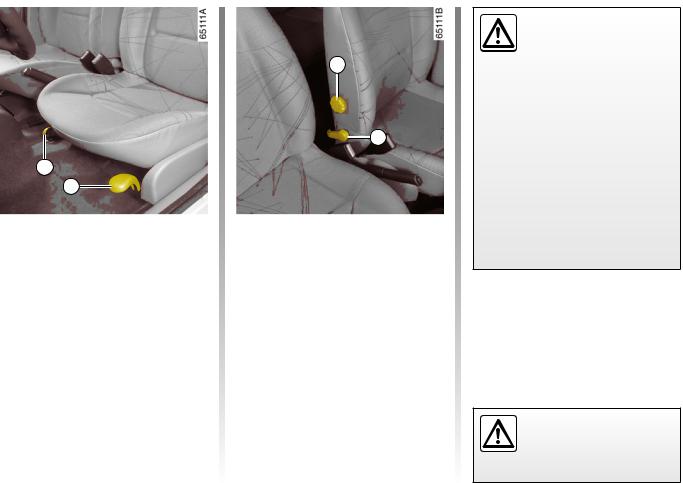
FRONT SEATS
1 |
2 |
To move forwards or backwards
Lift lever 2 to unlock the seat. When the seat is in the required position, release the lever and ensure that the seat is locked in place.
To raise or lower the driver’s seat
Move lever 1.
3 |
4 |
To tilt the seatback
Move handle 4 and tilt the seatback to the desired position.
To adjust the lumbar support on the driver’s seat
Turn control knob 3.
We would advise you not to recline the seatbacks too far to ensure that the effectiveness of the seat belts is
not reduced.
Make sure that the seatbacks are locked in place correctly.
Nothing should be placed on the floor (area in front of driver) as such objects may slide under the pedal during braking manoeuvres, thus obstructing its use.
For safety reasons, make these adjustments only when the vehicle is stationary.
1.12

FRONT SEATS (continued)
5 |
6 |
Access to the rear seats
(three-door versions)
Lift lever 5 and slide the seat forwards.
To return the seat to its original (stored) position on the driver’s side, slide the seat backwards until it locks.
ð HeatedWith the ignitionseats switched on, press the switch located on the rail cover 6. An indicator light will light up on the instrument panel.
The system, which has a thermostat, decides whether or not the heating is needed.
1.13

SEAT BELTS
Always wear your seat belt when travelling in your vehicle. You must also comply with the legislation of the particular country you are in.
Before starting:
–first ensure that your driving position is correctly adjusted,
–then adjust your seat belt to provide maximum protection.
Incorrectly adjusted seat belts may cause injuries in
the event of an accident.
Even pregnant women should wear a seat belt. In this case, ensure that the lap belt is not exerting too much pressure on the abdomen without allowing any slack.
Adjusting your driving position
–Sit well back in your seat (having first removed your coat or jacket). This is essential to ensure your back is positioned correctly.
–Adjust the distance between the seat and the pedals.
Your seat should be as far back as possible while still allowing you to depress the clutch pedal fully. The seatback should be adjusted so that your arms are slightly bent when you hold the steering wheel.
–Adjust the position of your headrest.
For safety reasons, the top of the headrest must be level with the top of the head.
–Adjust the height of the seat.
This adjustment allows you to select the seat position which offers you the best possible view.
–Adjust the position of the steering wheel.
1 |
2 |
Adjusting the seat belts
Sit with your back firmly against the seatback.
Shoulder strap 1 should be as close as possible to the base of the neck but not on it.
Lap belt 2 should be worn flat over the thighs and against the pelvis.
The belt should be worn so that it is as close as possible to your body, i.e.: avoid wearing heavy clothing or allowing bulky objects under the belts.
1.14

SEAT BELTS (continued)
3 |
Adjusting the front seat belt shoulder strap height
Move button 3 to select the position you require so that shoulder strap 1 is worn as described above.
Make sure that the seat belt is locked in position correctly after you have adjusted it.
6 |
4 |
5 |
|
|
|
|
|
6 |
Fastening
Unwind the belt slowly and smoothly and ensure that buckle 4 locks into catch 6 (check that it is locked by pulling on buckle 4). If the belt jams, allow it to return slightly before attempting to unwind it again.
Fastening (continued)
If your seat belt becomes completely jammed:
–pull the belt slowly but firmly so that just over 3 cm unwinds;
–then allow the seat belt to rewind automatically;
–unwind it again;
–if there is still a problem, contact your RENAULT Dealer.
çSeat belt reminder warning light
This lights up continuously if the driver’s seat belt is not fastened and, when the vehicle reaches a speed of approximately 6 mph (10 km/h), it flashes and a bleep sounds for approximately 90 seconds before the light returns to continuously lit status.
Unfastening
Press button 5 on catch 6 and the seat belt will be rewound by the inertia reel.
Guide the buckle to help the operation.
1.15

METHODS OF RESTRAINT IN ADDITION TO THE FRONT SEAT BELTS
These are:
–Front seat belt pretensioners.
–Force limiter.
–Air bags for driver and front passenger.
These systems are designed to act independently or together when the vehicle is subjected to a frontal impact.
There are three possibilities, depending on the level of impact force:
–protection is provided by the seat belt only;
–the pretensioner is triggered to rectify belt position and take up seat belt slack;
–the air bag and the force limiter are also triggered when there are severe impacts.
–Side air bags are provided to deploy in the event of severe side impacts.
 1
1
Front seat belt pretensioners
With the ignition switched on, if the vehicle is subject to a significant frontal impact the system may, depending on the severity of the impact, trigger piston 1 which instantly retracts the belt.
The pretensioners hold the seat belt against the body, holding the occupant more securely against the seat, thus increasing the seat belt’s efficiency.
–Have the entire restraint system checked following
an accident.
– No operation whatsoever is permitted on any part of the system (pretensioners, air bags, computers, wiring) and the system components must not be reused on any other vehicle, even if identical.
–Toavoidincorrecttriggeringofthe system which may cause injury, only qualified RENAULT Network personnel may work on the pretensioner and air bag system.
–The ignition module electrical specifications may only be tested by a specially trained technician using special equipment.
–When the vehicle is scrapped, contact your RENAULT Dealer for disposal of the pretensioner and air bag gas generators.
1.16

METHODS OF RESTRAINT IN ADDITION TO THE FRONT SEAT BELTS (continued)
Force limiter
Above a certain level of impact force, this mechanism is used to limit the force of the belt against the body so that it is at an acceptable level.
Air bags for driver and front passenger
An “Air bag” marking on the steering wheel and dashboard and a label on the lower section of the windscreen inform you of the presence of additional means of restraint (air bags, pretensioners, etc.) in the passenger compartment.
The air bag system consists of:
–for the driver: an adaptable air bag and its two gas generators (for the small or large volume bag depending on the severity of the frontal impact) mounted on the steering wheel;
–for the passenger: an air bag and its gas generator mounted in the dashboard.
Note: this passenger air bag is adaptable for right-hand drive versions.
–a computer for both systems, which includes the impact detector and a monitor controlling the electrical trigger system for the gas generators;
–a single åtell-tale light on the instrument panel.
The air bag system uses pyrotechnic principles. This explains why, when the air bag inflates, it will generate heat, produce smoke (this does not mean that a fire is about to start) and make a noise upon detonation. In a situation where an air bag is required, it will inflate immediately and this may cause some minor, superficial grazing to the skin or other problems.
1.17
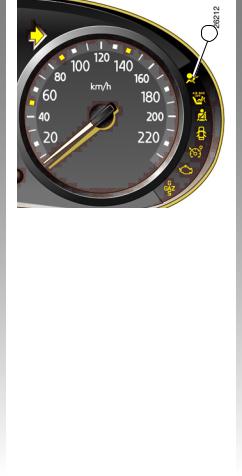
METHODS OF RESTRAINT IN ADDITION TO THE FRONT SEAT BELTS (continued)
Operation
The system is not operational until a few seconds after the ignition has been switched on.
If a severe frontal impact occurs, the air bag(s) inflate(s) rapidly, cushioning the impact of the driver’s head and chest against the steering wheel and the front passenger’s head against the dashboard. The air bag(s) then deflate(s) immediately so that the passengers are not impeded in any way as they exit the vehicle.
1 |
Operating faults
Warning light 1 will light up on the instrument panel when the ignition is switched on and then go out after a few seconds.
If it does not light up when the ignition is turned on, there is a fault in the system.
If it lights up while you are driving, stop at once and switch off the ignition.
If it remains lit after the ignition has been switched on again, there is a fault in the system.
It is not recommended to let a passenger use this seat.
Contact your RENAULT Dealer as soon as possible.
1.18

METHODS OF RESTRAINT IN ADDITION TO THE FRONT SEAT BELTS (continued)
All of the warnings below are given so that the air bag is not obstructed in any way when it is inflated and also to prevent the risk of serious injuries caused by items which may be dislodged when the air bag inflates.
The air bag is designed to complement the action of the seat belt. Both the air bags and seat belts are integral parts of the same protection system. It is therefore essential to wear the seat belt at all times. If seat belts are not worn, the occupants of the vehicle are at risk of serious injury in the event of an accident. The risk of minor superficial injuries occurring when the air bag is deployed may also increase, although such minor injuries are always possible with air
bags.
If the vehicle should overturn or suffer a rear impact, however severe, the pretensioners and air bags are not always triggered. Impacts to the underside of the vehicle from pavements, holes, stones etc. can all trigger these systems.
Air bags for driver and front passenger
–No work or modification whatsoever may be carried out on any part of the driver or passenger air bag system (air bag, pretensioner, computer, wiring harness, etc.), except by qualified RENAULT Network personnel;
–To ensure that the system is in good working order and to avoid accidental triggering of the system which may cause injury, only qualified RENAULT Network personnel may work on the air bag system;
–As a safety precaution, have the air bag system checked if your vehicle has been involved in an accident, or is stolen or broken into;
–When selling or lending the vehicle, inform the user of these points and hand over this driver’s handbook with the vehicle;
–When scrapping your vehicle, contact your RENAULT Dealer for disposal of the gas generator(s).
1.19

METHODS OF RESTRAINT IN ADDITION TO THE FRONT SEAT BELTS (continued)
A
All the warnings below are given so that air bag activation is not obstructed in any way and also to prevent the risk of serious injuries caused by items which may be dislodged when the air bag inflates.
Warnings concerning the driver’s air bag
– Do not modify the steering wheel or the steering wheel boss.
–Do not cover the steering wheel boss under any circumstances.
–Do not attach any objects (badge, logo, clock, telephone holder, etc.) to the steering wheel boss.
–The steering wheel must not be removed (except by qualified personnel from the RENAULT Network).
–When driving, do not sit too close to the steering wheel. Sit with your arms slightly bent (see the information on “Adjusting your driving position” in Section 1). This will allow sufficient space for the air bag to deploy correctly and be fully effective.
Warnings concerning passenger air bag: location A
–Do not attach or glue any objects (badges, logo, clock, telephone holder, etc.) onto the front passenger side of the dashboard.
–Do not place anything between the dashboard and the passenger (pet, umbrella, walking stick, parcels, etc.).
–The passenger must not put his or her feet on the dashboard or seat as there is a risk that serious injuries may occur. In general, parts of the body should be kept away from the dashboard (knees, hands, head, etc.).
A REAR-FACING CHILD SEAT MUST NOT BE FITTED
TO THE FRONT PASSENGER SEAT IF THE VEHICLE
IS EQUIPPED WITH A PASSENGER AIR BAG.
1.20
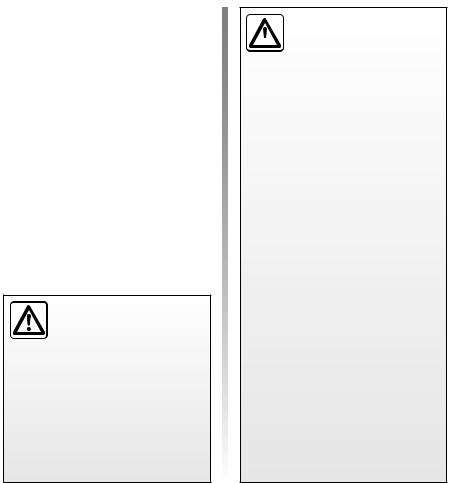
SIDE PROTECTION DEVICES
Side air bags
These air bags may be fitted to the front seats and are deployed at the sides of the seats (door side) to protect the occupants in the event of a severe side impact.
These air bags operate through slits in the front seatbacks (door side): never insert any objects in
these slits.
Warnings concerning the side air bag
 – Fitting seat covers: seats equipped with an air bag require covers specifi-
– Fitting seat covers: seats equipped with an air bag require covers specifi-
cally designed for your vehicle. Contact your RENAULT Dealer to find out if these covers may be purchased from RENAULT accessory outlets. The use of any other covers (including those designed for another vehicle) may affect the operation of these air bags and reduce your protection.
–Do not place any accessories, objects or even animals between the seat back and the door. Do not cover the seatback with any items such as clothes or accessories. This may prevent the air bag from operating correctly or cause injury when the air bag is deployed.
–Only qualified RENAULT network personnel may remove or modify a seat.
1.21
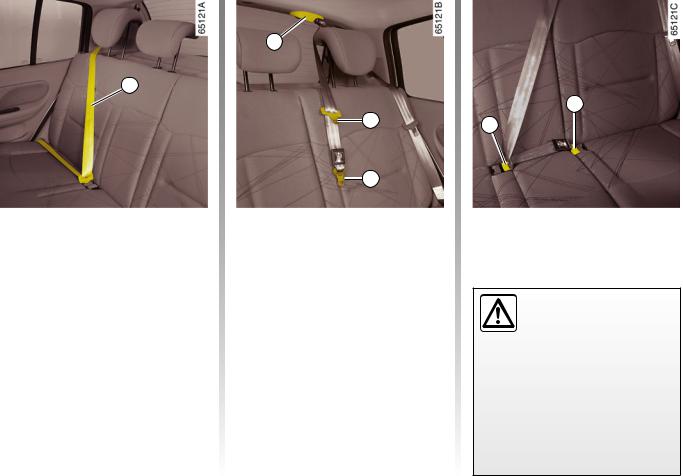
REAR SEAT BELTS
1 |
Rear side seat belts 1
The belts are locked, unlocked and adjusted in the same way as the front belts.
2 |
3 |
4 |
Rear centre belt
Unwind belt 2 slowly from its housing. Click buckle 4 into the black catch 6.
Snap the last sliding buckle 3 into the red catch 5.
5 |
6 |
Make sure that the rear bench seat is locked in position correctly so that the seat belts will operate effi-
ciently.
Refer to the information on the “Rear bench seat” in Section 3.
1.22

REAR SEAT BELTS (continued)
A
6 |
5 |
B
Special note concerning vehicles with a two-part rear bench seat
If you have to fold down the part of the rear bench seat behind the front lefthand seat:
–lift the seat base B against the front seat;
–click buckle 4 into the black catch 6;
–lower the seatback A (after removing the headrest).
Then snap the last sliding buckle 3 into the red catch 5.
Systems in addition to the rear seat belts:
Force limiter
Above a certain level of impact force to the front, this mechanism is used to limit the force of the belt against the body so that it is at an acceptable level.
1.23
